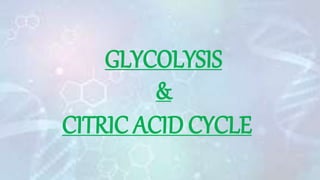
GLYCOLYSIS.pptx
- 2. WHAT IS GLYCOLYSIS? WHAT IS CITRIC ACID CYCLE? PATHWAYS ENERGETICS AND SIGNIFICANCE PATHWAYS ENERGETICS AND SIGNIFICANCE
- 3. WHAT IS GLYCOLYSIS Glycolysis is the process in which glucose is broken down to produce energy. It produces two molecules of pyruvate, ATP, NADH and water. The process takes place in the cytoplasm of a cell and does not require oxygen. It occurs in both aerobic and anaerobic organisms. Glycolysis is the primary step of cellular respiration, which occurs in all organisms. Glycolysis is followed by the Krebs cycle during aerobic respiration. In the absence of oxygen, the cells make small amounts of ATP as glycolysis is followed by fermentation. Glycolysis takes place in the cytosol of a cell.
- 4. Glucose Glucose 6 phosphate Fructose 6 phosphate Fructose 1,6 biphosphate Dihydroxy acetone phosphate Glyceralde hyde 3 phosphate 1,3 biphospho glycerate 3- phosphor glycerate 2- phosphogly cerate Phosphoph enoyl pyruvate pyruvate ATP TO ADP ATP TO ADP 2NAD + 2P__ 2NADH+2H+ ATP TO ADP H20 ATP TO ADP
- 5. hexokinase phosphoglucomutase phosphofructokinase aldolase Triosephosphate isomerase Glyceraldehyde 3- phosphate dehydrogenase Phosphoglycerate kinase phosphoglyceromutase enolase Pyruvate kinase Enzymes involved in glycolysis.
- 7. Energetics and significance of glycolysis Anaerobic glycolysis occurs in the absence of oxygen, during insufficiency of oxygen, and in case of the high demand of energy in the muscles, the anaerobic glycolysis pathway occurs. As the RBCs lack mitochondria, they derive energy from lactic acid fermentation. Another example where anaerobic respiration takes place is in the lens of the eye. Lactic Acid fermentation: This process occurs in the absence of oxygen in the muscles where lactate is converted into pyruvate with the help of an enzyme called lactate dehydrogenase. Two processes occur under anaerobic glycolysis, they are: Ethanol Fermentation: In this process, glucose gets converted into ethanol instead of pyruvate.
- 8. Significanceof glycolysis Most of the energy used by cells comes from glucose. It is one of the ancient pathways that is seen as it is used by all living organisms. It is the first pathway that is used to convert glucose into energy. It is the first main metabolic pathway of cellular respiration that produces energy in the form of ATP
- 9. Citric acid cycle or krebs cycle
- 10. What is citric acid cycle? The Krebs cycle or TCA cycle (tricarboxylic acid cycle) or Citric acid cycle is a series of enzyme catalysed reactions occurring in the mitochondrial matrix, where acetyl-CoA is oxidised to form carbon dioxide and coenzymes are reduced, which generate ATP in the electron transport chain. Cellular respiration is a catabolic reaction taking place in the cells. It is a biochemical process by which nutrients are broken down to release energy, which gets stored in the form of ATP and waste products are released. In aerobic respiration, oxygen is required. the Krebs cycle reactions take place in the mitochondrial matrix
- 11. PATHWAY
- 13. Energeticsand significance of citricacid cycle •Krebs cycle or Citric acid cycle is the final pathway of oxidation of glucose, fats and amino acids. •Regulation of Krebs cycle depends on the supply of NAD+ and utilization of ATP in physical and chemical work. •Many intermediate compounds are used in the synthesis of amino acids, nucleotides, cytochromes and chlorophylls, etc. •It is the major source of ATP production in the cells. A large amount of energy is produced after complete oxidation of nutrients. •Many animals are dependent on nutrients other than glucose as an energy source.